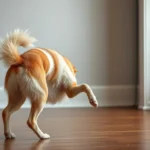
Introduction
Have you ever noticed how your dog lights up at the sight of a ball? Whether it’s a bright tennis ball or a squeaky toy, many dogs exhibit an irresistible fascination with these round objects. This phenomenon isn’t merely a quirky trait; it’s rooted in their instincts, psychological needs, and even their history as a species. Understanding why dogs love balls can enhance your relationship with your furry friend and improve their quality of life.
Understanding dog behavior is crucial for owners. It helps in creating a nurturing environment and promotes healthier interactions between dogs and their humans. This article delves into the reasons behind dogs’ love for balls, exploring psychology, sensory appeal, and even health benefits.
The Psychology of Dogs
Understanding Canine Instincts
Dogs are descendants of wolves, and many of their behaviors are influenced by their ancestral instincts. The instinct to chase and retrieve is deeply ingrained, stemming from their hunting heritage. In the wild, wolves would chase down prey, and this instinct has been preserved in domesticated dogs. When they see a ball, it often triggers a primal response, leading to excitement and engagement.
The Importance of Play
Play behavior in dogs is not just about having fun; it serves several essential functions. Engaging in play helps dogs develop social skills, build physical strength, and maintain mental agility. Play can also be a way for dogs to express their emotions, relieving stress and anxiety. A well-played dog is a happy dog, and understanding this aspect of behavior is vital for any responsible dog owner.
Bonding Through Play
When dogs play, they form stronger bonds with their owners and other dogs. Interactive playtime fosters a sense of trust and companionship, enhancing the relationship between pet and owner. Additionally, socialization during play with other dogs is crucial for developing good behavior and communication skills.
The Appeal of Balls to Dogs
Sensory Attraction
Dogs experience the world differently than humans, and their sensory perceptions play a significant role in their attraction to balls.
-
Vision: Dogs have dichromatic vision, meaning they see fewer colors than humans. However, they are particularly sensitive to bright colors, especially blue and yellow. This heightened perception makes brightly colored balls especially appealing to them.
-
Sound: Many balls come equipped with squeakers, providing auditory stimulation that captivates dogs. The sound mimics that of prey, further activating their chase instincts and encouraging them to engage.
-
Texture: The various materials used in balls, from rubber to fabric, offer different tactile experiences. Dogs often enjoy the sensation of chewing and carrying these toys, making texture an important factor in their attraction.
The Thrill of the Chase
The instinct to chase is hardwired in dogs. When they see a ball roll or bounce, it mimics the erratic movement of prey, triggering a chase response. This instinct not only provides physical exercise but also mental stimulation, as they must assess speed and direction. Engaging in this chase reinforces their natural behaviors and satisfies their instincts.
Retrieving Instincts
Certain breeds, such as retrievers, have been specifically bred to excel in fetching and retrieving tasks. These dogs possess a strong genetic predisposition to chase and bring back objects. However, even non-retrievers can exhibit retrieving behaviors, demonstrating that the allure of balls extends beyond specific breeds. This instinctual behavior is an essential part of a dog’s identity and provides a fulfilling outlet for their energy.
Types of Balls and Their Appeal
Different Ball Types
When it comes to balls for dogs, variety is key. Different types of balls cater to various preferences and play styles:
-
Standard Tennis Balls: Popular and widely accessible, tennis balls are a favorite for many dogs. Their size and bounce make them easy to chase.
-
Rubber Balls: Known for their durability and bounce, rubber balls withstand rough play and can be a great choice for strong chewers.
-
Squeaky Balls: These add an auditory element that many dogs find irresistible. The sound captures their attention and encourages prolonged play.
-
Interactive Balls: With advancements in technology, interactive balls that launch or roll on their own are becoming popular. These engage dogs in a new way, providing mental stimulation and excitement.
Choosing the Right Ball for Your Dog
When selecting a ball for your dog, consider the following factors:
-
Size: Ensure the ball is appropriately sized for your dog to prevent choking hazards. Smaller breeds may need smaller balls, while larger breeds may require bigger options.
-
Material: Choose durable materials that can withstand your dog’s chewing habits. Look for non-toxic options to ensure safety during play.
-
Safety: Always check for loose parts or damages that could pose risks to your dog. Investing in high-quality toys is crucial for your pet’s safety.
The Role of Training and Behavior Modification
Training Dogs to Fetch
Training your dog to fetch a ball can be a rewarding experience that enhances your bond. Here are the basic steps:
-
Start with the Basics: Introduce the ball to your dog and encourage them to show interest. Use treats to motivate them.
-
Teach the Fetch Command: Use a clear command like “fetch” to signal the start of the game.
-
Reinforce with Rewards: When your dog retrieves the ball, offer praise or treats to reinforce positive behavior.
-
Practice Consistently: Regular practice is key to developing this skill. Keep sessions short and fun to maintain your dog’s interest.
Addressing Behavioral Issues
While many dogs love balls, some may develop obsessive behaviors or aggression over their toys. Here are strategies for managing these issues:
-
Set Boundaries: Teach your dog to drop the ball on command to prevent possessiveness.
-
Supervise Playtime: Keep an eye on play sessions, especially when multiple dogs are involved, to ensure everyone plays safely.
-
Provide Alternatives: If your dog shows signs of obsession, offer different toys or activities to redirect their focus.
Enrichment Activities
Incorporating balls into enrichment activities can enhance your dog’s playtime. Consider activities such as:
-
Fetch Games: Classic games of fetch can be made more exciting with different throwing techniques or distances.
-
Obstacle Courses: Create a mini obstacle course that includes balls as part of the challenge.
-
Puzzle Toys: Use balls that dispense treats to engage your dog mentally while they play.
Health Benefits of Playing with Balls
Physical Exercise
Playing with balls is an excellent way to ensure your dog gets regular exercise. Chasing and retrieving promotes cardiovascular health, builds muscle strength, and helps maintain a healthy weight. Different breeds and ages may require varying levels of activity, so tailor playtime accordingly to meet your dog’s needs.
Mental Stimulation
Engaging in play not only benefits a dog’s physical health but also stimulates their mind. Balls can be used in various games that challenge dogs to think critically and solve problems. This mental engagement is essential for keeping a dog happy and reducing boredom, which can lead to destructive behaviors.
Stress Relief
Playtime with balls serves as a natural stress reliever for dogs. It allows them to release pent-up energy and reduces anxiety levels. Regular play can prevent behavioral issues that arise from stress, such as excessive barking or chewing.
Conclusion
Understanding why dogs love balls involves exploring their instincts, sensory perceptions, and the many benefits of play. Engaging with your dog through play not only strengthens your bond but also promotes their physical and mental well-being.
Encouraging play with balls can transform your dog’s life, providing them with joy, exercise, and mental stimulation. Remember, every dog is unique, so take the time to discover what type of balls and activities resonate with your furry friend. Happy playing!









